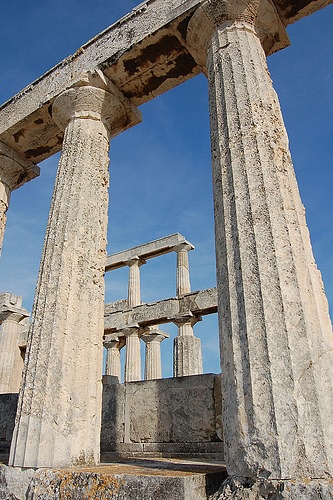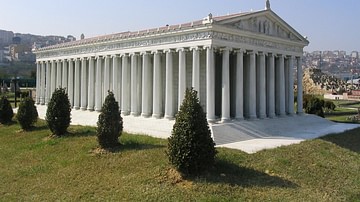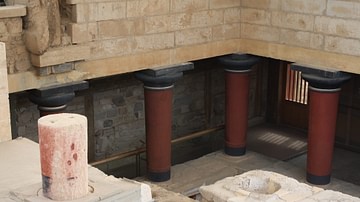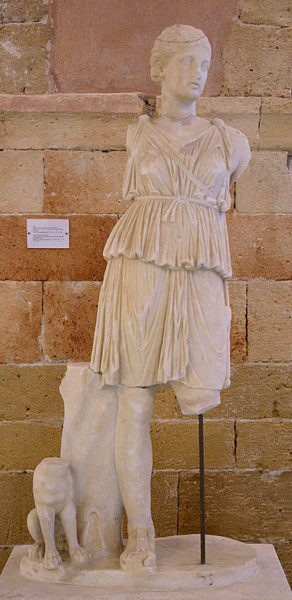
Britomartis, also known as Diktynna (Dictynna), was the Cretan goddess of hunting and fishing nets in Greek mythology. Although referred to as a nymph and worshipped locally, she had at least two significant and active shrines, one in Crete and another in Aigina, where worshippers would bring offerings. They regarded her as a vanished maiden immortalized and deified by Artemis.
According to her most popular myth, Britomartis, meaning "sweet maiden," was an exceptional huntress and a beloved companion of Artemis. As such, she had vowed to remain a virgin. Nevertheless, King Minos desired her and relentlessly pursued her for nine months. He eventually caught her atop a high peak and attempted to seize her, but Britomartis leaped from the cliff into the sea to escape. She was recovered by fishermen's nets (diktuon) and brought to the island of Aigina. There, Artemis transformed her into the goddess of the nets, Diktynna, to preside over her own cult.
Despite her clear Cretan origins, Britomartis/Diktynna was likely a minor goddess who was reintroduced into the Bronze Age pantheon of the island by Classical Greek writers. Over time, Diktynna came to be associated with divine genealogies and was even included among the children of Leto by Zeus, Apollo and Artemis. Her cult remained popular throughout the Hellenistic and Roman Imperial periods, as evidenced by the archaeological remains of her sanctuaries and the coins bearing her image.
In Minoan Religion
The Cretan system of sacred beliefs and practices is marked by impressive processions, bountiful sacrifices and offerings, mystery symbols such as the double-axe (labrys), and ritual activities such as bull-leaping. It also features painted and sculpted images of female characters commonly interpreted as goddesses or priestesses, most typically with raised arms. Some of these goddesses/priestesses are shown holding snakes, which led Sir Arthur Evans (1851-1941), the key figure in the discovery of the Minoan civilization, to suggest they may represent a 'Great Mother Goddess' and her fellow associates.
The discovery of numerous inscriptions at Knossos, an archaeological site he believed to be King Minos' palace, convinced Evans that deciphering these inscriptions would reveal a clear understanding of his material finds and their significance in the Minoan religion and culture. He dedicated his life to this effort, only to find that the inscriptions represented three different scripts: Cretan Hieroglyphs, Linear A, and Linear B. While the first two scripts remain undecoded, the Linear B script was eventually deciphered by Michael Ventris (1922-1956). As nearly all the tablets read since then contain administrative and commercial records, understanding the Minoan religion has largely remained dependent on drawing parallels between pieces of visual evidence from art, archaeology, and architecture. In other words, we have no written evidence yet that can directly tell us what the Minoans used to call their goddess or goddesses.
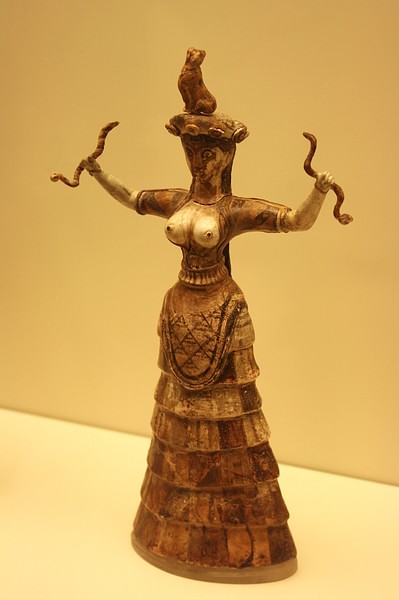
Still, there is a foundational agreement among the scholars that the Minoan religion, like many other aspects of this culture, was later adopted or adapted by the Mycenaeans and Greeks. Just as Michael Ventris demonstrated that the language of Linear B inscriptions is an early form of Classical Greek, scholars such as Jennifer Larson explain that
From its beginnings in the Bronze Age, “Greek” religion was a synthesis. The strong influence of Minoan ideas and aesthetics is clearly discernible in the material culture of Mycenaean religion…
(138)
The idea of the persisting prominence of several gods and goddesses such as Zeus, Apollo, Dionysus, and Athena from the Minoan down to the Mycenaean and Greco-Roman cultures finds material support in the names of these deities on a few Linear B tablets. These tablets were discovered at the Palace of Nestor in the Mycenaean city of Pylos, c. 1200 BCE. The tablets list the offerings and sacrifices that were dedicated, or must be dedicated, to each deity. On one tablet, Tn 316, the divine recipients of gold vessels include Zeus, Hermes, Hera, and Potnia. The name Potnia, written as po-ti-ni-ja in Linear B, means "The Female God Who Has Power." This title was given to several important goddesses in Minoan Crete, sometimes as an epithet, e.g. Potnia Athena, sometimes denoting the geographical or functional attribute of the goddess, e.g. Potnia Hippia (Mistress of the Horses), and sometimes solely as her name or title. If we trust that Potnia must be the Minoan/Mycenaean designation for sacred female figures in the Minoan art because they are both noticeably frequent, then it is likely that this Minoan/Mycenaean great goddess survived the Bronze Age Collapse and made her way into the Archaic Greek pantheon in the form of one or more female deities.
Since the Bronze Age goddess was often featured concerning warfare and protection, most scholars suggest that Athena is the Greek revival of Potnia. Nevertheless, the Cretan goddess, who was consistently honoured and praised by Greek writers from the 5th century BCE onwards, was Britomartis/Diktynna. And she was explicitly linked to Artemis and, later, to her divine family.
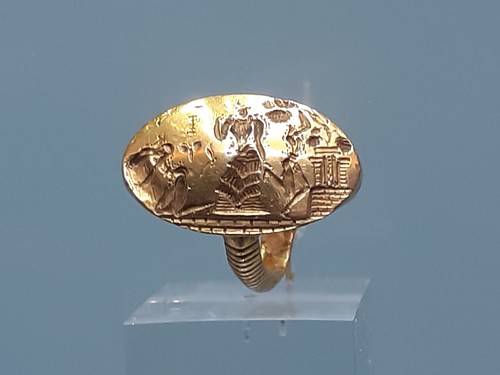
In Classical Greece
Even though the line of association between the Cretan goddess or goddesses entitled Potnia and the local protectress of hunters and fishermen known as Britomartis/Diktynna is not clear, this Cretan deity was certainly known and widely worshipped in the Classical, Hellenistic, and Roman eras. In 5th century BCE Athens, she is appealed to in Aristophanes' comedies for her powers over the fishing nets and hunting:
The best way is to gnaw through the net. Oh! Diktynna, goddess who watchest over the nets, forgive me for making a hole in this one.
(Wasps, 367)
O Artemis, thou maid divine, Diktynna, huntress, fair to see, O bring that keen-nosed pack of thine, and hunt through all the house with me. O Hekate (Hecate), with flameful brands.
(Frogs, 1358)
Diktynna's connection to Artemis recurs continuously in ancient Greek literature, emphasising the popularity of her legend in Classical Greece. The earliest extant account of this legend appears in Callimachus' Hymn 3, to Artemis.
And beyond others thou [Artemis] lovest the Nymphe of Gortyn [in Crete], Britomartis, slayer of stags, the goodly archer; for love of whom was Minos of old distraught and roamed the hills of Krete. And the Nymphe would hide herself now under the shaggy oaks and anon in the low meadows. And for nine months he roamed over crag and cliff and made not an end of pursuing, until, all but caught, she leapt into the sea from the top of a cliff and fell into the nets of fishermen which saved her. Whence in after days the Kydonians (Cydonians) call the Nymphe Diktyna (Lady of the Nets) and the hill whence the Nymphe leaped they call the hill Diktaion (Of the Nets), and there they set up altars and do sacrifice.
(188 ff)
The central sanctuary of Diktynna in Crete, the Diktynnaion, was located on the mount Dikte near Kydonia (modern Chania) at the northwest coast of the island. According to Herodotus, a famous visitor of the precincts in the 5th century BCE, the shrine of Diktynna was built by the colonists from Samos during their short period of dwelling there c. 524-519 BCE (Histories, 3.59).
Diodorus Siculus (1st century BCE), while focusing on the Cretan worship of Britomartis/Diktynna in connection with Artemis, presents her as the daughter of Zeus and Karme, and a granddaughter of Demeter (5.76.3). Pausanias (2nd century CE) agrees with this lineage but replaces Demeter with Karmanor, who purified Apollo after he killed Pytho. Pausanias also adds that Diktynna was immortalized by Artemis and that her cult spread to Aigina, where she was worshipped exclusively as Aphaia (or Aphaea, meaning 'On Her Own') (2.20.3). This suggests that, in some parts of the Greek world during the Hellenistic period, Britomartis/Diktynna was included in the group of deities related to Leto's children, Artemis and Apollo.
Roman Period & Beyond
The oldest findings on the site of the Diktynnaion sanctuary date back to the late 7th or 6th century BCE. In the Hellenistic period, the sanctuary of Britomartis/Diktynna was most likely under the control of the city of Polyrrhenium, not far from Kydonia. Polyrrhenium was probably founded during the Greek Archaic period and continued to exist in the Byzantine era. In the Late Hellenistic period, perhaps after the final Roman conquest of Crete in 66 BCE, the sanctuary of Diktynna was partially rebuilt. Its culminating flourish, however, took place when a new temple arose under the Roman emperor Hadrian (r. 117-138 CE). As a result, Diktynna's cult came to special prominence. She also appeared on Roman coins, where her connection to Zeus, this time as his divine mother, and to the Cretan myth of his infant life in the Idaean Cave were highlighted.
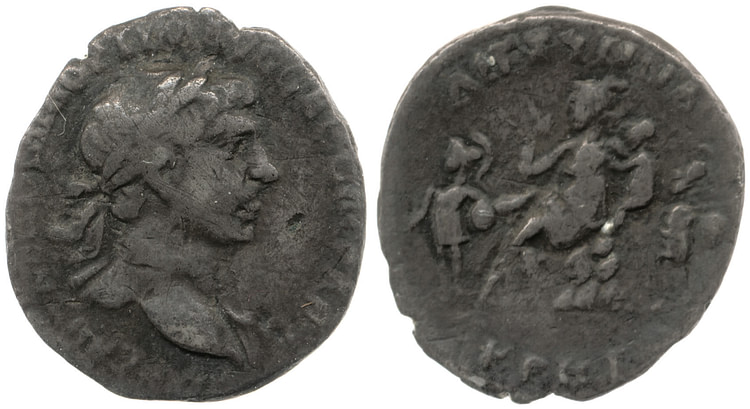
Diktynna and her sanctuary must have looked fascinating. Her cult and charisma inspired a vast range of ancient writers of the time, from Silius Italicus (c. 215 BCE) to Ptolemaeus and Apuleius (2nd century CE). According to Philostratus, the sanctuary was visited by Apollonios of Tyana in the mid-first century CE. The wealth of the sanctuary was so enormous that it was guarded by dogs as strong as bears, at least as the Cretans claimed (Philostratus, Life of Apollonios 8.30). Worshippers from across Greece and the Mediterranean would travel to the site, bringing offerings. It was customary for them to approach barefoot, carrying their valuable gifts in direct contact with the earth and nature, which were embodied by the goddess.
The Temple of Aphaia in Aegina, a Doric structure made of limestone measuring c. 30 by 13 meters, was built around 500 BCE to replace an earlier wooden temple that had been destroyed by fire. The discovery of numerous female figurines from the 14th century BCE suggests the continued worship of a mother-goddess of Minoan origin at this site. The Archaic temple housed a significant collection of sculptures, which were looted by Ludwig I of Bavaria (r. 1825-1848 CE) and taken to Munich. These sculptures, along with the remains of the temple, are now displayed at the Staatliche Antikensammlungen und Glyptothek.

